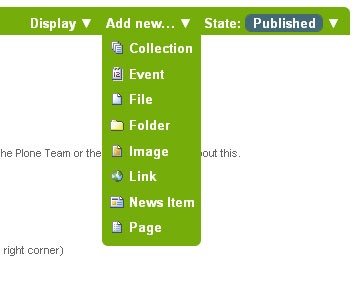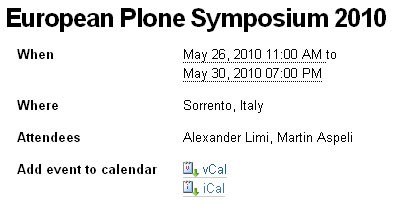How To Add Content to the Portal: A General Overview
Would you like to contribute?
You can contribute content to this website. Content includes: web pages, files, links, images, news items, and calendar events.
Here's how.
First, you must be a member of this website to add, edit, or remove content.
To become a member, click the Register box located next to the Log In box to request a membership.
You can contribute to:
- Resources
Add public content here. -
Group Folders: Private Collaboration These folders are private among members of a designated group. As long as this content stays in a private state, the public cannot view or collaborate on this content. Only members of the private group can view this content. If you would like to join a private group, email the Portal Administrator.
Add private collaborative group content here. - News: Add news items here.
- Events: Add calendar events here.
New content items are added via the Add New . . . drop-down menu:

Adding content in Plone is done placefully, which is to say that you must navigate to the section of your Plone website that you wish the new content to reside before you use the Add New . . . drop-down menu. You can of course cut, copy, and paste content items from one section to another if necessary.
Content Types
In Plone, you can use a number of Content Types to post certain kinds of content. For example, to upload an image you must use the Image content type. Below is a list of the available content types in order of their appearance, and what each are used for:
- Collection
- Collections are used to group and display content based on a set of criteria which you can set. Collections work much like a query does in a database.
- Event
An Event is a special page-like content type specifically for posting information about an event (such as a fundraiser, barbecue, etc). This content type has a function which allows the site visitor to add the event to their desktop calendar with either the iCal or vCal standard. This includes applications such as: Google Calendar, Outlook, Sunbird and others.
To add a single event to your calendar, click on the vCal or iCal links next to the "Add event to calendar" text in the main view of the event item.

From Plone 3.3 on you can also get all the events in a folder in one go (currently only available in iCal format). To download the iCal file, append @@ics_view to the end of the URL of the folder that contains the events. For example, if you want to get all the events into the events folder in the root of your site, go to http://yourdomain.tld/events/@@ics_view. There are plans to provide a link to this iCal calendar inside the UI in a future release.
- File
- A File in Plone is any binary file you wish to upload with the intent that it can be downloaded by your site visitors. Common examples are PDFs, Word Documents, and spreadsheets.
- Folder
- Folders work in Plone much like they do on your computer. You can use folders to organize your content, and to give your Plone website a navigation structure.
- Image
- The Image content type is used for uploading image files (JPG, GIF, PNG) so that you can insert them into pages or other page-like content types.
- Link
- Also referred to as the 'Link Object'; do not confuse this with the links you create via TinyMCE or Kupu, Plone's visual page editors. The Link content type is often used to include a link to an external website in Navigation and other specialized uses.
- News Item
- This content type is similar to Event, only News Item is specifically for posting news. You can also attach a thumbnail image to a News Item, which then appears in folder summary views next to the summary of the News Item.
- Page
- A Page in Plone is one of the most simple content types available. Use Pages to write the bulk of your web pages on your Plone website.
Note: Depending on what add-on products you have installed, you may see more options in your Add New . . . drop-down menu than appear here. For information about those additional content types, refer to the Product documentation for the add-on in question.
Title
Nearly all content types in Plone have two fields in common: Title and Description.
The Title of content items, including folders, images, pages, etc., can be anything you want -- you can use any keyboard characters, including blanks. Titles become part of web address for each item you create in Plone. Web addresses, also known as URLs, are what you type in a web browser to go to a specific location in a web site (Or, you would click your way there), such as:
www.mysite.com/about/personnel/sally/bio
or
www.mysite.com/images/butterflies/skippers/long-tailed-skippers
Web addresses do have restrictions on allowed keyboard characters, and blanks are not allowed. Plone does a good job of keeping web addresses correct by using near-equivalents of the Title that you provide, by converting them to lowercase, and by substituting dashes for spaces and other punctuation.
The web address of a given item is referred to as the short name in Plone. When you use the Rename function, you'll see the short name along with the title.
The fields will vary according to the content type. For instance, the Link content type has the URL field. The File content type has the File field, and so on.
Description
The Description appears at the top of pages, just under the Title. Descriptions are often used to conjunction with a variety of Folder and Collection views (such as Standard and Summary). The Description also appears in search results via Plone's native search engine.
Document Actions


